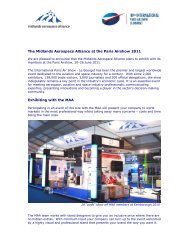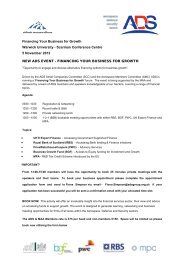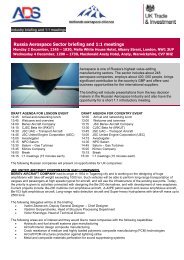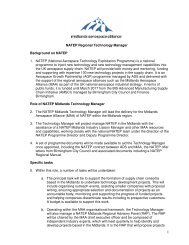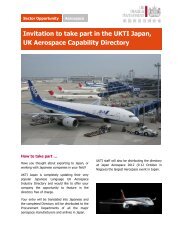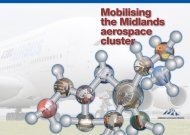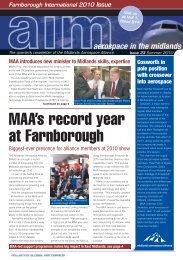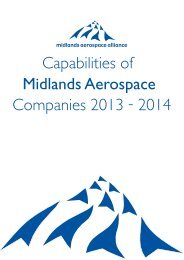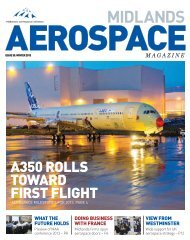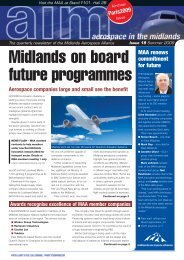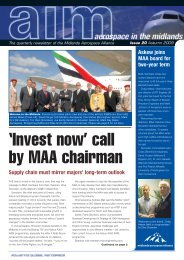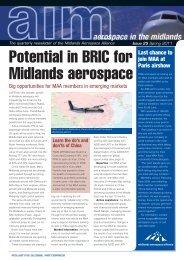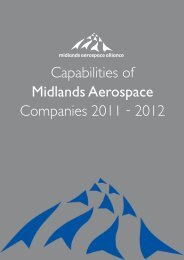new technology for aerospace
here - Midlands Aerospace Alliance
here - Midlands Aerospace Alliance
You also want an ePaper? Increase the reach of your titles
YUMPU automatically turns print PDFs into web optimized ePapers that Google loves.
Aerospace in the Midlands<br />
<strong>new</strong> <strong>technology</strong> <strong>for</strong> <strong>aerospace</strong><br />
The British Midlands is home to one of the world’s most significant <strong>aerospace</strong> clusters.<br />
Leading <strong>aerospace</strong> names such as Rolls-Royce, Goodrich, Meggitt and Smiths are major<br />
players in the region.<br />
The Midlands has a long and distinguished association with <strong>technology</strong> innovation <strong>for</strong> the<br />
<strong>aerospace</strong> industry and is world-renowned <strong>for</strong> its core competency technologies:<br />
• systems that power aircraft - gas turbine engines and other propulsion<br />
systems<br />
• systems that control the moving parts of aircraft and engines – electrical,<br />
mechanical, electronic, hydraulic and pneumatic<br />
• specialist metal and composite materials that enable these systems to<br />
per<strong>for</strong>m with precision in exacting environments<br />
• specialist engineering design services, factory equipment and tooling<br />
In the Midlands, <strong>aerospace</strong> companies access and continually upgrade a regional skills<br />
base renowned <strong>for</strong> its engineering excellence, with more than 45,000 skilled people working<br />
in the <strong>aerospace</strong> cluster directly. In total, over 700 supply chain companies contribute their<br />
capabilities to global <strong>aerospace</strong> in a business environment that fosters the highest levels of<br />
innovation. The Midlands universities play an essential role as powerhouses of <strong>aerospace</strong><br />
knowledge.<br />
The Midlands Aerospace Alliance (MAA) unites the whole <strong>aerospace</strong> cluster - from Rolls-<br />
Royce to the smallest company, from university researchers to private consultants, and<br />
from trade unions to local government and skills and training agencies. With strong<br />
support from two regional development agencies working in partnership -- Advantage<br />
West Midlands and the East Midlands Development Agency -- the MAA’s vision is of an<br />
internationally recognised, sustainable <strong>aerospace</strong> industry, creating wealth and opportunity<br />
<strong>for</strong> the entire Midlands region.<br />
Tel: 0845 225 0503<br />
Email: info@midlands<strong>aerospace</strong>.org.uk<br />
www.midlands<strong>aerospace</strong>.org.uk<br />
The Midlands Universities
Midlands <strong>technology</strong> genius <strong>for</strong> global <strong>aerospace</strong><br />
Foreword .................................................................. 1<br />
Midlands map .......................................................... 2<br />
How to use this guide ............................................. 3<br />
The Universities:<br />
Aston University ................................................ 4<br />
University of Birmingham ................................ 6<br />
Coventry University .......................................... 8<br />
De Mont<strong>for</strong>t University ................................... 10<br />
University of Leicester ................................... 12<br />
Loughborough University .............................. 14<br />
University of Nottingham ............................... 16<br />
University of Warwick ..................................... 18<br />
University of Wolverhampton ........................ 20<br />
University of Derby ......................................... 22<br />
Nottingham Trent University .......................... 22<br />
University of Central England ........................ 23<br />
Organisations and links ........................................ 24<br />
About funding ........................................................ 26<br />
Teaching and courses matrix ............................... 28<br />
Technology capabilities matrix ............................. 29<br />
The Midlands universities are the lifeblood of our region’s world-renowned<br />
excellence in engineering <strong>technology</strong>. Three of the United Kingdom’s<br />
leading five universities, measured by numbers of engineering graduates,<br />
are located in the Midlands – Birmingham, Coventry and Loughborough.<br />
Our universities are tightly linked to the success of our automotive, power<br />
generation, electronics and other engineering sectors.<br />
The Midlands has a long and distinguished association with <strong>technology</strong><br />
innovation <strong>for</strong> the <strong>aerospace</strong> industry; both the jet engine and radar were<br />
first developed here. From global powerhouses such as Rolls-Royce,<br />
along the whole <strong>aerospace</strong> supply chain to small agile firms, <strong>technology</strong><br />
innovation has translated into leading positions <strong>for</strong> Midlands <strong>aerospace</strong><br />
companies on the most advanced <strong>aerospace</strong> programmes of today — and<br />
tomorrow — including the Airbus A380, Boeing 787, Joint Strike Fighter<br />
and Eurofighter Typhoon.<br />
Our universities host national and global centres of research excellence<br />
that play leading roles in the continuing success of the Midlands<br />
<strong>aerospace</strong> cluster. They have developed specialist expertise along with<br />
Midlands companies in such areas as: clean gas turbine technologies,<br />
more-electric control systems, specialist fuel cells, high-temperature<br />
and lightweight materials, and innovative development, tooling and<br />
manufacturing techniques. Midlands university <strong>technology</strong> expertise is<br />
also sought after by the wider national and global <strong>aerospace</strong> industry. Our<br />
research centres in areas such as helicopter and UAV controls, systems<br />
engineering, and photonics increasingly attract the interest of global<br />
<strong>aerospace</strong> companies.<br />
All this expertise is set out <strong>for</strong> the first time in the Midlands Aerospace<br />
Alliance guide to <strong>new</strong> technologies <strong>for</strong> <strong>aerospace</strong> at Midlands universities.<br />
The guide illustrates the full potential of close collaboration and <strong>technology</strong><br />
transfer between the university sector and industry. As chairmen of the<br />
West Midlands Innovation and Technology Council and Innovation East<br />
Midlands, we are proud of the contribution our knowledge base makes<br />
to the Midlands’ continuing success in global <strong>aerospace</strong> markets. We<br />
share the goal of building on this guide to further enhance these links<br />
between the university research and teaching community and industry in<br />
the Midlands and globally.<br />
Clive Hickman<br />
Chairman<br />
West Midlands Innovation and<br />
Technology Council<br />
Barry Stickings CBE<br />
Chairman<br />
Innovation East Midlands<br />
This brochure was compiled and written by Maike Ockoniewski.<br />
The engine graphic used in the headers of the university pages was kindly supplied by Roll-Royce plc.
Midlands map<br />
University of Derby<br />
Nottingham University<br />
Nottingham Trent<br />
University<br />
Loughborough University<br />
How to use this guide<br />
This guide has been produced to introduce the many different <strong>aerospace</strong> <strong>technology</strong><br />
activities at universities in the British Midlands.<br />
For quick reference consult the capability matrix in the back of the brochure. It gives<br />
an overview of a wide range of <strong>aerospace</strong> research, from engineering to manufacturing<br />
and management. In addition, there is a separate matrix that lists relevant courses and<br />
modules that are taught at the universities. Bespoke training courses can usually be<br />
arranged utilising these modules.<br />
For more detailed in<strong>for</strong>mation about each university’s activities please consult the<br />
university profiles. Each profile includes a case study presenting one of the major<br />
<strong>aerospace</strong> projects carried out at the university and a summary of other ways the<br />
university supports <strong>aerospace</strong> <strong>technology</strong> development.<br />
To find out even more, simply get in touch with the listed contact person. Details are<br />
included at the end of each university profile.<br />
University of Wolverhampton<br />
University of Central England<br />
Aston University<br />
Coventry University<br />
De Mont<strong>for</strong>t University<br />
University of Leicester<br />
University of Birmingham<br />
University of Warwick<br />
2
Aston is known <strong>for</strong> world-class research and teaching, and its graduate<br />
employment record is second to none – due in part to the fact that many<br />
students spend a year working in industry as part of their studies. The<br />
university’s cutting-edge research provides the plat<strong>for</strong>m <strong>for</strong> a range of<br />
services relevant to <strong>aerospace</strong> companies throughout the Midlands, the<br />
UK and globally.<br />
CASE STUDY: Photonics <strong>for</strong> smart structures<br />
The Photonics Research Group at Aston includes over 50 people working<br />
at a number of well-equipped laboratories. Research areas include highspeed<br />
telecommunications, fibre Bragg gratings, femtosecond laser<br />
inscription, polymeric fibre design and fabrication, microwave photonics,<br />
biophotonics and optical sensing.<br />
Fibre Bragg grating sensing is one of the most exciting fibre <strong>technology</strong><br />
areas of recent years with widespread applications. It is particularly<br />
relevant to the <strong>aerospace</strong> industry since it allows easy monitoring of<br />
composite structures.<br />
At Aston the <strong>technology</strong> has been developed via a number of DTI and<br />
MoD funded research programmes in partnership with companies such<br />
as BAE Systems, Deutsch, Marconi and QinetiQ. The recently completed<br />
EMPIRE programme developed connectors <strong>for</strong> smart composite<br />
structures – making the <strong>technology</strong> suitable <strong>for</strong> volume manufacturing.<br />
Optical fibres can be used to monitor vibration, strain and temperature<br />
throughout a composite structure. Their small size enables them to be<br />
embedded within, or bonded to, structures making the system very<br />
robust. This <strong>technology</strong> can be applied to monitoring the in-service<br />
stresses of aircraft wings which allows operators to optimize servicing<br />
schedules according to work done rather than miles flown.<br />
Optical fibre sensors have a number of further advantages over<br />
conventional electrical strain gauges. They are immune to electromagnetic<br />
fields and it is possible to interrogate many measurement points using a<br />
single fibre – greatly reducing the complexity of installation.<br />
Polymer Processing & Per<strong>for</strong>mance Research Unit<br />
The research of the PPP Research Unit covers different stages of the<br />
polymer lifecycle, from synthesis to processing. The group also has<br />
expertise in the per<strong>for</strong>mance of specialty additives and polymers in<br />
service during first and subsequent lives. Another research field is<br />
polymer oxidation and ageing, where the effects of light and heat are<br />
investigated to improve the reliability and per<strong>for</strong>mance of polymers.<br />
In the <strong>aerospace</strong> industry exact knowledge of material lifetime issues is<br />
required. Services offered by PPP to the <strong>aerospace</strong> industry include:<br />
• the application of fundamental understanding to areas of polymer<br />
processing & per<strong>for</strong>mance;<br />
• the analysis & testing of properties, processability, stability,<br />
recyclability, and degradability, including the effects of additives.<br />
The PPP laboratories are equipped with a full suite of polymer processing<br />
facilities and state-of-the art tools including spectroscopic (e.g. FTIRmicroscopy,<br />
FTIR-ATR, Raman, UV-Vis-NIR, fluorescence and NMR),<br />
thermal and rheological (e.g. DMA, Hyper DSC, TGA and capillary<br />
rheometry), chromatographical characterization and testing techniques<br />
(e.g. HPLC and GC) as well as accelerated ageing and weathering<br />
devices.<br />
The In<strong>for</strong>mation Processing and Pattern Analysis Research<br />
Group<br />
The In<strong>for</strong>mation Processing and Pattern Analysis Research Group is<br />
an internationally recognized centre of excellence in artificial neural<br />
networks and advanced pattern processing methods <strong>for</strong> engineering<br />
applications.<br />
The Group’s expertise in the non-linear, dynamic and statistical processing<br />
of a wide range of data and applications problems has been applied to a<br />
number of areas relevant to the <strong>aerospace</strong> industry including: corrosion<br />
detection; condition monitoring, and fault prediction.<br />
Past and current <strong>aerospace</strong>-related projects include:<br />
• vigilance monitoring in pilots (BAE Systems); novel signal<br />
processing and analysis methods were used to determine alertness<br />
from an EEG signal;<br />
• fault modelling in gas turbine engines; Bayesian belief networks are<br />
used to model dependencies between engine components, thus<br />
improving diagnosis of faults.<br />
Contact:<br />
Links:<br />
4<br />
John Richards<br />
Business Partnership Unit<br />
0121 204 4254<br />
j.e.richards@aston.ac.uk<br />
www.aston.ac.uk/bpu<br />
Photonics Research Group: www.ee.aston.ac.uk/research/prg<br />
In<strong>for</strong>mation Engineering: www.ncrg.aston.ac.uk<br />
Polymer Processing and Per<strong>for</strong>mance Research Group:<br />
www.ceac.aston.ac.uk/research/groups/polymer/ppp<br />
5
The University of Birmingham is well established as a world-class<br />
university. The university was founded on Birmingham’s science and<br />
engineering base and now boasts an annual income of more than<br />
£270 million and over 20,000 students. The Department of Metallurgy<br />
and Materials Science in particular is a leading centre in materials and<br />
manufacturing processes <strong>for</strong> <strong>aerospace</strong> applications.<br />
CASE STUDY: Manufacture of net shape components<br />
The university has developed two manufacturing technologies <strong>for</strong> the<br />
production of net shape components. These technologies have been<br />
specially developed to be transferred into industry.<br />
Direct laser fabrication<br />
This is a <strong>technology</strong> which can manufacture net shape components from<br />
their CAD files and metal powders using a laser in a single step. The<br />
laser is used as heat source to melt the metal powder which is injected<br />
into the laser focal point. At the same time the laser moves following the<br />
paths defined by the CAD file of the component so that a 3-D fully dense<br />
metal component is built layer by layer. No mould and little machining are<br />
required in this process.<br />
The turn-over time <strong>for</strong> manufacturing a component is between one and a<br />
few days, dependent on the component size. This <strong>technology</strong> has a great<br />
advantage in manufacturing a small batch of bespoke components and<br />
in precision-repair of worn out components. The repair of an aero-engine<br />
component <strong>for</strong> Rolls-Royce using this process has been estimated to<br />
save annual maintenance costs of more than £10m.<br />
Hot isostatic pressing (HIPping)<br />
Net shape HIPping is a <strong>technology</strong> which can produce fully dense net<br />
shape large components from metal powder (e.g Ti, Ni) in one step with<br />
little machining of the components involved. The mechanical properties<br />
obtained are similar to wrought (with suitable alloys) and surface finish<br />
and accuracy are as good as investment casting. No material is wasted<br />
except the mild steel which is used as the mould material.<br />
Rolls-Royce University Technology Centre <strong>for</strong> Materials<br />
The Department of Metallurgy and Materials incorporates the Rolls-Royce<br />
UTC <strong>for</strong> titanium based materials. The UTC runs several research projects with<br />
topics such as the development of a burn resistant alloy <strong>for</strong> aeroengines and the<br />
exploitation of intermetallic TiAl alloys’ high strength and low density properties.<br />
The alloys can be used <strong>for</strong> wrought and cast parts <strong>for</strong> the Joint Strike Fighter.<br />
Cold hearth refining<br />
The usage of this production method bears several advantages <strong>for</strong> the<br />
production of moving aircraft components. Weight can be saved and fatigue<br />
failures can be reduced. Metallic items normally ultimately fail by cracking,<br />
and inclusions can act as the starting points <strong>for</strong> cracks. An inclusion of about<br />
20 millionths of a gram can lead to failure in a component a metre long.<br />
Cold hearth refining is successful at preventing inclusions from reaching the final<br />
product. During the melting process, high density inclusions sink and become<br />
trapped in the solid ‘skull’ of material at the bottom of the hearth. Low density<br />
inclusions float and can be removed by interaction with the heat source. Neutral<br />
density inclusions dissolve in the molten material, given appropriate conditions.<br />
Corrosion of high strength aluminium airframe alloys<br />
The group investigates the corrosion of welds under consideration <strong>for</strong> the<br />
next generation of aircraft structures. This includes the mechanisms of<br />
corrosion, relating microstructure to corrosion susceptibility and examining<br />
methods to prevent corrosion, e.g. laser surface treatment and post-weld<br />
heat treatment.<br />
Fuel cells research at the Department of Chemical Engineering<br />
Aircraft demand more and more energy <strong>for</strong> cabin services like air, water,<br />
heat and power. In future electric aircraft this power will be supplied from an<br />
auxiliary power unit (APU) which will probably be a pressurized gas turbinefuel<br />
cell hybrid. Fuel cells can provide a more efficient energy supply, which<br />
saves fuel and weight on board. Fuel cell systems can also be operated<br />
independently from the propulsion engines, raising fuel efficiency.<br />
Researchers in the Department of Chemical Engineering have been working<br />
with Airbus to demonstrate fuel cell <strong>technology</strong> <strong>for</strong> APUs using kerosene<br />
JETA1.<br />
Contacts:<br />
Alison Morey<br />
Outreach Fellow<br />
Dept of Electronic, Electrical and<br />
Computer Engineering<br />
0121 414 4342<br />
bruceal@bham.ac.uk<br />
Fuel Cells:<br />
Dr Maria R Kosseva<br />
m.r.kosseva@bham.ac.uk<br />
0121 414 5360<br />
Prof Kevin Kendall<br />
Chemical Engineering<br />
k.kendall@bham.ac.uk<br />
0121 414 2739<br />
Links:<br />
University of Birmingham<br />
www.bham.ac.uk<br />
IRC in Materials Processing<br />
www.irc.bham.ac.uk<br />
6 7
At Coventry University <strong>aerospace</strong> activity is especially focused on<br />
teaching. The university is one of the top five UK universities in terms<br />
of students taking engineering courses. Aerospace research at the<br />
university focuses on applied research with industrial partners.<br />
CASE STUDY: Aircraft tyre modelling<br />
A major factor affecting aircraft and landing gear strength requirements<br />
is the ground load generated at the tyre/ground interface. This, in turn,<br />
depends on tyre properties. System and aircraft level simulation models,<br />
which contain tyre models, are used through the whole life of an aircraft<br />
project from design to in-service support.<br />
Coventry University runs a project that aims to develop a mathematical<br />
model of the <strong>for</strong>ces and moments generated in the tyre contact patch.<br />
The current method of defining aircraft tyre characteristics is through<br />
extrapolated manufacturer’s data and data extracted from flight testing.<br />
This means that the validity of data used in load calculations is at risk<br />
until flight test results are achieved.<br />
Compared to tyre modelling in automotive industries where most available<br />
tyre models have been developed, aircraft tyre modelling is much more<br />
technically challenging. The project aim is to develop aircraft tyre models<br />
<strong>for</strong> tyre, system and aircraft level simulations. This work will lead to more<br />
accurate predictions of landing gear loads and aircraft manoeuvrability<br />
and better steering and braking systems.<br />
The project is funded by Airbus and the EPSRC.<br />
Research and <strong>technology</strong><br />
• Helicopter crash protection: To improve passenger safety, the<br />
European HeliSafe project used in<strong>for</strong>mation from historical flying<br />
accident investigations and developed an overall safety analysis<br />
and simulation tool using a generic computer mock-up and an<br />
aviation related crash dummy. The research group at Coventry<br />
University undertook computer simulations making extensive use of<br />
existing automotive <strong>technology</strong>.<br />
• Advanced actuation systems <strong>for</strong> electric aircraft: Research in<br />
this area has looked at electromechanical actuation systems <strong>for</strong><br />
aircraft primary flying controls, focusing on potential solutions <strong>for</strong><br />
hard jams.<br />
• Centre <strong>for</strong> Advanced Joining: The focus of the research at the<br />
Centre is in the area of high-energy beam processing, specifically<br />
plasma arc welding and industrial laser processing. Among<br />
the major clients of the Centre have been Rolls-Royce and<br />
AugustaWestland Helicopters. The Centre also houses the Laser<br />
Aided Material Processing (LAMP) project, which provides<br />
services and assistance to small companies.<br />
• The Design Institute has collaborated with a number of <strong>aerospace</strong><br />
companies including BAE Systems and Rolls-Royce.<br />
Courses and teaching<br />
The School of Engineering offers a number of undergraduate courses<br />
in <strong>aerospace</strong>, designed in close consultation with the <strong>aerospace</strong> industry<br />
and adopting an applied approach using current <strong>aerospace</strong> designs<br />
to explain theories and concepts. The course in Aerospace Systems<br />
Engineering includes modules in engineering design, avionic systems,<br />
thermofluids, aerodynamics, propulsion systems and <strong>aerospace</strong> industry<br />
studies, to name only a few.<br />
The two other <strong>aerospace</strong> degrees are Aerospace Technology and Avionics<br />
Technology. Technical resources include a specialised <strong>aerospace</strong><br />
laboratory complete with a Merlin Flight Simulator.<br />
Contacts:<br />
Links:<br />
Professor Peter R White<br />
Head of Mechanical Engineering Design<br />
024 7688 8367<br />
p.white@coventry.ac.uk<br />
Coventry University<br />
www.coventry.ac.uk<br />
Centre <strong>for</strong> Advanced Joining<br />
8<br />
http://web1.eng.coventry.ac.uk/centres/caj/main.htm<br />
9
The De Mont<strong>for</strong>t University has experience in the <strong>aerospace</strong> sector<br />
providing research, education, training and consultancy support to help<br />
companies become more cost effective and responsive to customer<br />
demands.<br />
CASE STUDY: Encompassing Lean<br />
The Lean Engineering Research Group has been involved in a range of<br />
projects including the EPSRC-funded CostMod and SimFMcL research<br />
programmes. CostMod delivers software tools <strong>for</strong> developing improved<br />
cost models <strong>for</strong> <strong>aerospace</strong> business processes in which cost in<strong>for</strong>mation<br />
is essential to effective decision-making. The SimFMcL project delivered<br />
software tools <strong>for</strong> the design and operation of multi-component versions<br />
of single-component flexible machining lines. These more versatile<br />
multi-component flexible machining lines permit ‘one piece flow’ lean<br />
manufacturing in the <strong>aerospace</strong> sector with its high levels of product<br />
complexity and low piece volumes.<br />
Recently, the first students from the university’s BSc (Hons) Lean<br />
Engineering degree graduated, a programme initially developed in<br />
collaboration with Rolls-Royce. Leading lean practitioners, Toyota and<br />
Unipart, sponsored Best Student and Best Project prizes. The range<br />
of areas involved in student projects included business improvement,<br />
supplier development, shop floor planning and control, cost model<br />
development and flow processing. Current PhD research, MSc by<br />
independent study projects and in-company training programmes are<br />
developing knowledge, expertise and tools in the same areas.<br />
In terms of consultancy, the group recently assisted a manufacturing<br />
organisation to improve the internal logistics involved in moving materials<br />
around their factory site by developing a computer simulation model of<br />
on-site vehicle movements and using this model to identify and resolve<br />
potential conflicts at traffic junctions. This enabled individual items to be<br />
moved over considerable distances from the end of one assembly line to<br />
the beginning of the next without line stoppages.<br />
Centre <strong>for</strong> Manufacturing<br />
The Lean Engineering and Rapid Manufacturing research groups are<br />
now part of the Centre <strong>for</strong> Manufacturing, which focuses on delivering<br />
support to regional <strong>aerospace</strong> companies through projects such as the<br />
Aerospace New Technology Institute Network (ANTIN). This project<br />
is providing capital equipment grants and training to small East Midlands<br />
<strong>aerospace</strong> companies to procure and use advanced manufacturing<br />
<strong>technology</strong> such as CNC milling equipment.<br />
MSc Rapid Product Development<br />
This course has been designed to enable its students to apply the <strong>new</strong><br />
range of rapid product development tools in a creative and competent<br />
way. The course addresses rapid prototyping and its associated<br />
technologies.<br />
More about De Mont<strong>for</strong>t University:<br />
• Rapid Prototyping and Manufacturing Group (RPMG): The focus<br />
of research lies in the reduction of product development lead-times<br />
and costs through the use of rapid prototyping and on the rapid<br />
manufacturing of high volume components using a combination of<br />
layer manufacturing and high speed printing <strong>technology</strong>. The group<br />
collaborates with Alstom, QinetiQ and Rolls-Royce.<br />
• Mechanical Engineering / Combustion and Computational Fluid<br />
Dynamics Research Group: The group investigates the internal<br />
aerodynamics of turbomachinery and develops mathematical<br />
models and computational fluid dynamic (CFD) codes as effective<br />
design tools to help designers to achieve improvements in various<br />
components such as blades.<br />
• Manufacturing support: The university offers support in the<br />
fields of computer aided design, rapid prototyping, prototype tool<br />
manufacture and others.<br />
• High temperature materials: The Faculty of Health and Life<br />
Sciences is undertaking work in high temperature materials and<br />
polymer safety <strong>for</strong> <strong>aerospace</strong> use.<br />
• Technical textiles: the university houses one of the UK’s leading<br />
research groups in textile technologies, supporting product<br />
innovation in the sector.<br />
Contact:<br />
Links:<br />
Reg Warren<br />
Business Development Manager<br />
Faculty of Computing Sciences and Engineering<br />
0116 250 6513<br />
rwarren@dmu.ac.uk<br />
De Mont<strong>for</strong>t University<br />
www.dmu.ac.uk<br />
10 11
The University has significant expertise in the <strong>aerospace</strong> sector, and is<br />
a preferred Academic Capability Partner (ACP) of BAE Systems. The<br />
partnership focuses on control systems, especially <strong>for</strong> uninhabited air<br />
vehicles (UAVs). The university also houses Europe’s largest academic<br />
centre <strong>for</strong> space research.<br />
CASE STUDY: UAV control systems<br />
Uninhabited air vehicles are becoming increasingly important, as they offer<br />
a variety of advantages over piloted vehicles - higher manoeuvrability,<br />
lower human risk, lower cost and less weight. They can be used <strong>for</strong><br />
weather and atmospheric monitoring, emergency communications,<br />
telecommunications, border patrol, battlefield deployment and other<br />
applications.<br />
As demands on UAVs increase they require higher levels of autonomy.<br />
To improve per<strong>for</strong>mance the Control and Instrumentation Group at the<br />
University of Leicester develops algorithms <strong>for</strong> flight path planning. These<br />
algorithms take several aspects into account. The probability of a hit has<br />
to be calculated and collisions with other vehicles have to be modelled.<br />
When flying at very low altitudes there is a possibility of crashing into<br />
ground objects such as trees or hills.<br />
Algorithms find waypoints that lead the UAV to the target avoiding such<br />
possible threats. The selected flight path reduces risk to the vehicle,<br />
and takes total distance and fuel costs into consideration to achieve<br />
optimum results.<br />
A number of technical requirements also have to be fulfilled. The<br />
systems have to be fast enough <strong>for</strong> real time use on airborne processors<br />
in uncertain environments, and they have to be efficient in terms of<br />
computer memory and computational demand.<br />
The research group at the University of Leicester has developed several<br />
models <strong>for</strong> flight path planning. Each takes different aspects into account<br />
to achieve high per<strong>for</strong>mance in different scenarios.<br />
Expertise at the Mechanics of Materials Research Group<br />
• Alloy developments <strong>for</strong> casting applications<br />
• Materials characterisation: Electron Microscopy (ESEM, FEGSEM,<br />
TEM); conventional and novel thermal analysis; mechanical testing;<br />
• Simulation of engineering materials - (i) the effects of processing on<br />
material properties and (ii) the expected per<strong>for</strong>mance of engineering<br />
components under their designed operating conditions;<br />
• Tribological behaviour and surface coatings to optimise surface<br />
behaviour;<br />
• Semisolid processing (i.e. processing metallic alloys in the<br />
semisolid state) of <strong>aerospace</strong> grade aluminium alloys (e.g. 7075) to<br />
reduce manufacturing cost; the feasibility of semisolid processing<br />
of titanium alloys is under investigation;<br />
• Modelling surface roughness and contact phenomena that depend<br />
on this.<br />
Thermofluids and Environmental Engineering Research Group<br />
Some of the group’s research topics include:<br />
• Turbomachinery aerodynamics, with special emphasis on the<br />
modelling of unsteady shear layers; experimental work has focused<br />
on boundary layer transition.<br />
• The dynamics of separated, reattaching and recirculating flows;<br />
vortex dynamics of micro air vehicles; coherent structuring in<br />
turbulent flow and aerodynamic and acoustic influences on<br />
practical combustion and heat transfer processes.<br />
• The aerodynamic instability of transonic cavities, jets, and<br />
turbomachinery blading flows; a specific interest in jet screech<br />
and trailing edge wake flows is leading to the further development<br />
of time-accurate numerical models that jointly address unsteady<br />
aerodynamics and noise.<br />
The Space Research Centre<br />
The Centre houses the Space Research Group of the Department of Physics<br />
and Astronomy at the University of Leicester. It carries out the space<br />
research programme of the University in collaboration with members of the<br />
Department. The main activities of the Space Research Centre are in the<br />
areas of instrumentation and missions <strong>for</strong> space astrophysics, planetary<br />
science, earth observation science, <strong>technology</strong> transfer and exploitation,<br />
undergraduate and postgraduate education, and public outreach.<br />
Contact:<br />
Tim Maskell<br />
Research and Business Development Office<br />
0116 223 1372<br />
twom1@le.ac.uk<br />
Links:<br />
University of Leicester<br />
www.le.ac.uk<br />
Mechanics of Materials Research Group<br />
www.le.ac.uk/eg/research/groups/mechmats<br />
Thermofluids and Environmental Engineering Research Group<br />
www.le.ac.uk/eg/research/groups/thermofluids<br />
Space Centre<br />
www.le.ac.uk/slcem/leicester-space-centre.html<br />
12 13
Housing one of Rolls-Royce’s flagship University Technology Centres<br />
(UTCs) and the Systems Engineering Innovation Centre (SEIC – a<br />
partnership with BAE Systems and the East Midlands Development<br />
Agency), Loughborough University undertakes a wide range of <strong>aerospace</strong><br />
research and <strong>technology</strong> development.<br />
CASE STUDY: University Technology Centre in Combustion<br />
Aerodynamics<br />
The Loughborough Rolls-Royce UTC conducts a range of experimental<br />
and computational research to improve our understanding of the<br />
complex aerodynamic processes that govern the behaviour of gasturbine<br />
combustion systems and associated components. The UTC<br />
possesses unique test facilities, which allow fully-annular, enginerepresentative<br />
combustion systems to be studied. Smaller scale rigs<br />
are employed to explore the spatially- and temporally-resolved flow<br />
fields of system components. A range of instrumentation is used, from<br />
multi-hole pneumatic pressure probes to advanced non-intrusive optical<br />
techniques.<br />
Recently, increased emphasis has been placed on understanding the<br />
detailed unsteady fluid mechanics of combustion systems. Unsteady<br />
processes are critical to the occurrence of instabilities, and to the<br />
achievement of low emissions per<strong>for</strong>mance. This has increased the need<br />
<strong>for</strong> laser doppler anemometry (LDA) and particle image velocimetry (PIV)<br />
data, and 3D mapping of the turbulence field.<br />
To complement these experimental studies, computational fluid<br />
dynamics (CFD) is used to provide predictions of combustion system<br />
aerodynamics. Several recent projects have explored the potential of the<br />
large eddy simulation (LES) approach to provide insight into unsteady<br />
features of the flow, with notable improvements achieved compared to<br />
the more conventional statistical turbulence model CFD approach.<br />
The UTC receives research funding from Rolls-Royce, EPSRC, DTI,<br />
and the EU. The Centre has carried out studies on the combustion<br />
aerodynamics of the whole range of the Trent series of Rolls-Royce<br />
engines, including the latest Trent 900 <strong>for</strong> the Airbus A380. Work is just<br />
beginning at Loughborough on the Trent 1000 design selected <strong>for</strong> the<br />
Boeing 787 Dreamliner aircraft.<br />
Research in the Department of Aeronautical and Automotive<br />
Engineering is organized into 6 groups:<br />
Dynamics and control: The group develops advanced dynamics and<br />
control techniques and <strong>new</strong> methods <strong>for</strong> simulation, dynamic analysis<br />
and advanced control.<br />
Acoustics and vibration: The focus of this group is on the development of<br />
low-noise and low-vibration aircraft and automotive vehicles.<br />
Structures: The group’s research is aimed at improved methods to realise<br />
safe structural design, with a special emphasis on composite materials.<br />
Risk and reliability: This group works on the development of mathematical<br />
models to assess the reliability of engineering systems.<br />
Energy and combustion: Covering a range of activities, state of the art<br />
techniques are developed and applied to engineering applications such<br />
as fuel cells and novel fuel injectors <strong>for</strong> ic-engines.<br />
Applied aerodynamics: as well as hosting the Rolls-Royce UTC in Gas<br />
Turbine Combustion Aerodynamics this group undertakes experimental<br />
research (low speed wind-tunnel, high pressure nozzle testing) on<br />
vehicle, supersonic jet plume and damaged wing aerodynamics, and<br />
computational research into jet noise and Short Take Off Vertical<br />
Landing (STOVL) aircraft.<br />
Training: The department offers a number of relevant training courses and<br />
modules ranging from management to systems engineering and design.<br />
Modules can be trans<strong>for</strong>med into special training <strong>for</strong> companies.<br />
The Systems Engineering Innovation Centre (SEIC) was set up<br />
in 2003 as a partnership between Loughborough University, BAE<br />
Systems and the East Midlands Development Agency. The Centre offers<br />
research, training and consulting in all aspects of systems engineering,<br />
including requirements capture, risk analysis, systems architecture,<br />
rapid prototyping and lifecycle management amongst other product<br />
and service development activities. The SEIC is also leading the UK<br />
Aerospace Innovation Network (AIN) in Systems Engineering.<br />
Loughborough University also runs the Innovative Manufacturing<br />
and Construction Research Centre (IMCRC). Together with industry<br />
partners such as Alstom, BAE Systems, Goodrich and Rolls-Royce,<br />
the group undertakes research covering <strong>new</strong> <strong>technology</strong>, business,<br />
organisational per<strong>for</strong>mance and human factors.<br />
Contacts:<br />
Ken Astley<br />
Business Development<br />
k.r.astley@lboro.ac.uk<br />
01509 635208<br />
Dr Ayman El-Fatatry<br />
SEIC<br />
01509 63 5203<br />
a.el-fatatry@lboro.ac.uk<br />
Links:<br />
Department of Aeronautical and Automotive Engineering<br />
www.lboro.ac.uk/departments/tt<br />
SEIC<br />
www.seic-loughborough.com<br />
IMCRC<br />
14 www.lboro.ac.uk/departments/eng/research/imcrc<br />
15
Aerospace is a major research theme at Nottingham, where several<br />
departments deliver innovative solutions in collaboration with industry<br />
leaders such as Rolls-Royce, BAE Systems, and Smiths Aerospace.<br />
CASE STUDY: Electrically Driven Advanced Actuator Systems<br />
The EDAAS project is financed under the Department of Trade and Industry<br />
(DTI) CARAD program and involves engineers from Smiths Aerospace<br />
Mechanical Systems (Wolverhampton), Semelab and Nottingham<br />
University. The team comprises engineers from power electronic,<br />
thermal, mechanical, semiconductor packaging and electromechanical<br />
disciplines. The program is producing a demonstrator test rig <strong>for</strong><br />
<strong>technology</strong> incorporating the first integrated electromechanical actuator<br />
with matrix converter power electronics and electric motor drive. The<br />
target is to develop the <strong>technology</strong> <strong>for</strong> a compact, self-contained<br />
actuator system with minimum EMC problems and with only electrical<br />
and mechanical connections.<br />
The matrix converter is a <strong>new</strong> <strong>for</strong>m of power electronic converter which<br />
eliminates the need <strong>for</strong> bulky, unreliable, temperature-sensitive energy<br />
storage capacitors required by existing converters. To obtain the best<br />
per<strong>for</strong>mance from the converter and to minimise the introduction of<br />
unwanted harmonics into the electrical supply the permanent magnet<br />
actuator motor has to be developed specifically to match the converter.<br />
The application chosen as a basis <strong>for</strong> the demonstrator is a 30kW rudder<br />
actuation system <strong>for</strong> a large civil aircraft. In normal service, the actuator<br />
is only subject to intermittent, transient loading of one or two seconds<br />
per operation as trim corrections are made. The particular challenge <strong>for</strong><br />
this application is the case of one engine of a twin-engined aircraft failing<br />
mid-flight. Under this condition, the rudder, and thus actuator, needs to<br />
provide a compensating moment to keep the aircraft flying straight. This<br />
amounts to a half-load condition at zero motor speed which must be<br />
sustained <strong>for</strong> at least two hours until the nearest airport is reached. The<br />
sustained load imposes a substantial thermal challenge <strong>for</strong> an integrated<br />
converter which has been solved by specially engineered heat sinks<br />
which <strong>for</strong>m part of the actuator.<br />
More activities at the university:<br />
• Innovative Manufacturing Research Centre (IMRC): provides<br />
a knowledge driven approach to advanced manufacturing<br />
<strong>technology</strong>, including lightweight structures manufacturing and<br />
responsive manufacturing. The IMRC hosts the Rolls-Royce<br />
University Technology Centre in Manufacturing Technology.<br />
• The Structural Integrity and Dynamics Research Group is<br />
developing transmission systems using advanced computational<br />
methods and incorporates a second Rolls-Royce University<br />
Technology Centre in Gas Turbine Transmission Systems.<br />
• The Thermofluids Research Group investigates complex air/<br />
oil flows typical of bearing chambers and air/oil separators and<br />
the development of advanced in-situ optical flow and particle<br />
monitoring.<br />
• The Composite Materials Group has an international reputation in<br />
polymer composites and processes required to <strong>for</strong>m structures <strong>for</strong><br />
advanced <strong>aerospace</strong> and automotive applications.<br />
• The Advanced Materials Group focuses on processing techniques<br />
such as light alloys, powder processing and surface engineering.<br />
• The Power Electronics Machines and Control Group is<br />
internationally renowned <strong>for</strong> an integrated approach to the design<br />
of motor, power electronic drive, mechanical actuator and thermal<br />
systems.<br />
• The Ultrasonics and Non-destructive Evaluation Group is a<br />
leader <strong>for</strong> industrial plant applications and advanced electronic<br />
plat<strong>for</strong>ms to support rapid application of <strong>new</strong> measurement and<br />
monitoring techniques.<br />
• The Institute of Engineering Surveying and Space Geodesy:<br />
key themes are GPS, Galileo, optimised position-orientation<br />
integration, radar, photogrammetry, hyperspectral scanners, LIDAR,<br />
and simulation of navigation and communication systems <strong>for</strong> the<br />
European and British Space Agencies.<br />
• The University of Nottingham Business School has strong<br />
relationships with Rolls-Royce through the MBA programme and<br />
the Operational Management Group which researches multidisciplinary<br />
developments in <strong>technology</strong> and rapid product<br />
development.<br />
Contacts:<br />
Regional Business Development<br />
2heads@nottingham.ac.uk<br />
www.nottingham.ac.uk/businesscommunity<br />
Prof Jon Clare<br />
School of Electrical and<br />
Electronic Engineering<br />
Tel: 0115 951 5546<br />
jon.Clare@nottingham.ac.uk<br />
Links:<br />
The University<br />
www.nottingham.ac.uk<br />
Nottingham Innovative Manufacturing Research Centre<br />
www.nimrc.nottingham.ac.uk<br />
16 17
A division of the School of Engineering, Warwick Manufacturing Group<br />
(WMG) offers a variety of research and consultancy services and is<br />
actively involved in support <strong>for</strong> <strong>aerospace</strong> <strong>technology</strong> development<br />
at the national and European levels. The WMG mission is to improve<br />
competitiveness through the application of value added skills, innovation<br />
and <strong>new</strong> technologies, and the group benefits from the expertise of over<br />
300 members of staff.<br />
WMG plays a key role in the UK Lean Aerospace Initiative (UKLAI), and is a<br />
partner in the National Advisory Committee <strong>for</strong> Aerospace Manufacturing<br />
(NACAM). WMG has a tradition of close collaboration with <strong>aerospace</strong><br />
companies including Airbus, BAE Systems, GKN, Meggitt/Dunlop, Rolls-<br />
Royce and Smiths.<br />
CASE STUDY: Rapid Manufacture of High Integrity Aerospace<br />
Components (RAMAC)<br />
WMG partnered with BAE Systems and GKN in the RAMAC project.<br />
Different rapid prototyping technologies were tested <strong>for</strong> their accuracy,<br />
processing lead-time and volume and cost limitations. The aim was to<br />
identify different techniques that would allow companies to produce high<br />
integrity <strong>aerospace</strong> components in low volumes at minimal cost.<br />
During the research eight major processes were tested, among them<br />
laminating, laser sintering cast<strong>for</strong>m and MJM thermojet. To test the<br />
different processes the industrial partners presented a variety of<br />
components incorporating critical design features to be found across<br />
many <strong>aerospace</strong> components. The pieces varied in wall thickness, size<br />
and shape, posing different requirements <strong>for</strong> reproduction. Qualities<br />
investigated included accuracy, surface finish, maximum part size and<br />
cost. The outcome of the project was a matrix showing engineers the<br />
individual qualities of the processes evaluated, including the advantages<br />
and disadvantages of each, and where the process’ ideal applications<br />
lie.<br />
Previous WMG <strong>aerospace</strong> research includes:<br />
• Quality and reliability: WMG was a partner in the Ultra Reliable<br />
Aircraft Project and subsequently the Reliability Enhancement<br />
Methodology and Modelling projects. Partners included Goodrich,<br />
Smiths, BAE Systems and Rolls-Royce<br />
• Concurrent engineering: WMG is participating in the EU funded<br />
VIVACE l Concurrent Engineering Project. The aim is to define a<br />
common way of working <strong>for</strong> joint European aeronautics product<br />
development projects.<br />
• Rapid Manufacturing: WMG is participating in the BAE Systems-<br />
EPSRC Integrated Programme of Research in Aeronautical<br />
Engineering which is addressing the grand challenge of a<br />
maintenance-free Unmanned Combat Air Vehicle (UCAV) without<br />
conventional control surfaces and no cost or per<strong>for</strong>mance<br />
penalties.<br />
• Research is undertaken in business areas related to <strong>technology</strong>,<br />
including legal and commercial issues involved in product<br />
introduction such as contracting, intellectual property and other<br />
legal obligations. The aim is to reduce time delays and lower<br />
commercial and legal barriers.<br />
Services to business<br />
• The Group’s knowledge transfer services focus on best practice,<br />
business management, manufacturing strategy, business<br />
processes, facilities improvement and rapid manufacturing.<br />
• Tailored courses and training <strong>for</strong> companies are also available.<br />
• The Innovation-Direct Programme delivers help in identifying <strong>new</strong><br />
markets, developing <strong>new</strong> products, improving existing products<br />
and using <strong>new</strong> business processes.<br />
Innovative Manufacturing Research Centre (IMRC): Pursuing a broad<br />
cross-sectoral approach, the IMRC achieves significant benefits by<br />
tailoring learning, technologies and systems from one sector to a <strong>new</strong><br />
one and by developing entirely <strong>new</strong> technologies and systems. Research<br />
projects focus on one of the three overarching themes of <strong>technology</strong>,<br />
design or management. Companies, academics, individuals or<br />
organisations are welcome to participate actively in the IMRC. Research<br />
partners included Rolls-Royce, BAE Systems, QinetiQ and the Society of<br />
British Aerospace Companies.<br />
Contacts:<br />
Nick Matthews<br />
Warwick Manufacturing Group<br />
n.matthews@warwick.ac.uk<br />
Dr Mark Bobe<br />
University of Warwick<br />
Industrial Development Officer<br />
Research Support Services<br />
02476 573178<br />
mark.bobe@warwick.ac.uk<br />
Links:<br />
Innovative Manufacturing Research<br />
Centre (IMRC)<br />
www.warwickimrc.ac.uk<br />
Innovation-Direct Programme<br />
www.innovation-direct.com<br />
Warwick Manufacturing Group<br />
www.warwick.ac.uk<br />
18 19
The University of Wolverhampton combines the abilities of several of its<br />
schools in the Research Institute in Advanced Technologies (RIATec).<br />
The Institute was founded in 2003. Based in the School of Engineering<br />
and the Built Environment, it involves staff from a range of schools and<br />
draws on the expertise of 50 active researchers and over 100 research<br />
students.<br />
RIATec people have strong links with industry and most of their research<br />
topics come straight from the real business world and address real<br />
problems and opportunities. About 30% of RIATec’s research work is<br />
relevant to the <strong>aerospace</strong> industry. The institute has worked in partnership<br />
with <strong>aerospace</strong> organisations such as Goodrich, BAE Systems and RAF<br />
Cos<strong>for</strong>d.<br />
CASE STUDY: High temperature dies<br />
High temperature dies are used <strong>for</strong> hot blow <strong>for</strong>ming (900 C°) of highper<strong>for</strong>mance,<br />
light-weight and complex <strong>for</strong>m structures that are required<br />
by the <strong>aerospace</strong> industry. With the help of an advanced finite element<br />
computer simulation, dies <strong>for</strong> the superplastic <strong>for</strong>ming process have been<br />
modeled. The original dies that were investigated were axisymmetric and<br />
had high principal stresses, which induced failure near the base of the<br />
<strong>for</strong>ming cavity.<br />
Large dies require a lot of heat energy and time to attain the correct<br />
temperature. Heating time increases with the square of the die size and it<br />
would be advantageous to reduce this time. However, there is a risk that<br />
increasing the speed of heating of the tooling will tear the die apart as the<br />
outside of the die expands too rapidly away from the colder interior.<br />
The computer simulation showed that it is possible to increase the<br />
speed of heating without breaking the die by using induction heating.<br />
This method is much more effective at getting the heat into the depth<br />
of the metal than surface heating. The depth of induction heating was<br />
modeled by including volume heating elements. This causes some<br />
spurious stresses in the heating region. To increase the possible heating<br />
rate even more the peak stresses near the die cavity are eliminated by<br />
putting holes around the cavity in a radial direction, so that they do not<br />
interrupt the heat flow. This method has been tested by constructing a<br />
3D model.<br />
Research and activities<br />
• Advanced computer modelling and simulation is a core strength,<br />
including engineering computer simulation and metal <strong>for</strong>ging<br />
simulation. Facilities include a virtual reality suite.<br />
• Materials research is undertaken in the areas of materials<br />
engineering and processing<br />
• Materials testing is carried out in the Zwick-Roell Materials &<br />
Product Testing Centre. The Centre was set up in partnership<br />
with Zwick-Roell and offers an extensive range of the company’s<br />
latest testing products, permitting testing in fracture, fatigue, high<br />
temperature and bespoke hydraulics.<br />
• Powder metallurgy: powder coatings are developed to improve<br />
the characteristics of materials (e.g. harden them) in the Nano-<br />
Powders Laboratory.<br />
• Superplastic <strong>for</strong>ming is a process in which metal can be made<br />
to flow in a nearly Newtonian creep manner. This is seen in blow<br />
<strong>for</strong>ming of plastic and glass and allows very large strains to be<br />
achieved and complex shapes <strong>for</strong>med, such as fan-blades and<br />
large heat-exchangers.<br />
• New product development: The Innovation Product Development<br />
Centre (IPDC) is a consultancy service tailored <strong>for</strong> small<br />
manufacturing firms. With £4m of equipment the Centre is able<br />
to assist in product design, manufacturing and materials as well<br />
as business processes and marketing. Services include 3D CAD<br />
modeling and simulation, planning <strong>for</strong> manufacture, selective laser<br />
sintering (SLS) rapid prototyping – metal and nylon parts, 5-axis<br />
and 4-axis CNC machining, 5-axis and 3-axis CNC EDM, reverse<br />
engineering and co-ordinate measurement.<br />
Courses and degrees<br />
The School of Engineering and the Built Environment offers a variety of<br />
engineering degrees and modules. Topics include materials, engineering<br />
systems, CAD, innovation & enterprise and others.<br />
A highlight of the School’s cooperation with industry is the special part<br />
time degree which focuses on supply chain management, with students<br />
from automotive and <strong>aerospace</strong> companies.<br />
Contact:<br />
Prof F. Richard Hall<br />
Director<br />
01902 322287 / 321000<br />
F.R.Hall@wlv.ac.uk<br />
Links:<br />
University of Wolverhampton<br />
www.wlv.ac.uk<br />
RIATec<br />
www.riatec.org.uk<br />
20 21
University of Derby<br />
In cooperation with Derby College and Rolls-Royce the university delivers a<br />
Foundation Degree in Mechanical and Manufacturing Engineering. This is offered<br />
as a part-time course, with contents that fit especially Rolls-Royce employees,<br />
and will be extended to full-time mode in the future. Other courses have also<br />
been developed in cooperation with Rolls-Royce.<br />
Courses in Quality Assurance are offered leading to City and Guilds and Institute<br />
of Quality Assurance Awards. The University can tailor short courses in a variety<br />
of subject areas (e.g. materials selection, CAD Modelling) many of which can<br />
lead to qualifications via Learn Through Work.<br />
The University of Derby is also a member of the East Midlands Aerospace New<br />
Technology Initiative Network (ANTIN), offering advanced <strong>technology</strong> development<br />
support including solidification modelling to small <strong>aerospace</strong> companies.<br />
Other areas of expertise are in manufacturing systems, robotics and expert<br />
systems.<br />
For more details contact:<br />
Dr John Begg MBA CEng<br />
Head of Design Division<br />
01332 591776<br />
j.begg@derby.ac.uk<br />
Nottingham Trent University<br />
The University’s Business School has carried out several <strong>aerospace</strong> research<br />
projects in the past. Two current research themes are:<br />
• Strategic suppliers: re-structuring in the equipment sector of the UK<br />
<strong>aerospace</strong> industry<br />
• High <strong>technology</strong> cluster? The <strong>aerospace</strong> cluster in the East Midlands region<br />
Consulting and training is also offered at the university, focusing mainly on<br />
management and management development.<br />
For more details contact:<br />
Prof David Smith<br />
Research Director<br />
0115 8484745<br />
david.smith02@ntu.ac.uk<br />
University of Central England (UCE)<br />
UCE’s Technology Innovation Centre (tic) provides a highly accessible environment<br />
where academia and the commercial sector communicate, interact and benefit<br />
from each other’s respective strengths.<br />
The Centre offers a comprehensive range of services and resources to make<br />
businesses more innovative and competitive. Support is offered through:<br />
• Innovation and <strong>technology</strong> management consultancy:<br />
providing tailor-made solutions to assist organisational development,<br />
including access to developmental <strong>technology</strong> grants.<br />
• Identification of <strong>new</strong> business opportunities:<br />
encouraging entrepreneurship and support of business initiatives though<br />
consultancy which will guide companies in seeking growth.<br />
• Developing <strong>technology</strong> solutions:<br />
tic’s applied research helps companies solve identified problems; key<br />
learning benefits are achieved on both sides.<br />
• Skills development programmes;<br />
enabling personnel to keep up with technological change and develop skills<br />
to improve their company’s per<strong>for</strong>mance.<br />
The tic is a major partner of the West Midlands Manufacturing Advisory Service<br />
(MAS), delivering consultancy and research to regional manufacturing companies,<br />
many of which supply <strong>aerospace</strong> customers.<br />
For more in<strong>for</strong>mation contact:<br />
John Thompson<br />
Programme Manager (MAS)<br />
0121 331 5400<br />
john.thompson@tic.ac.uk<br />
www.tic-online.com<br />
22 23
Organisations and links<br />
Regional Development Agencies<br />
RDAs were set up by Government to promote sustainable economic<br />
development in England. Their main tasks are to help the English regions<br />
improve their relative economic per<strong>for</strong>mance and reduce social and<br />
economic disparities within and between regions.<br />
East Midlands Development Agency: www.emda.org.uk<br />
Advantage West Midlands: www.advantagewm.co.uk<br />
Manufacturing Advisory Service (MAS)<br />
The regional manufacturing advisory services provide subsidised support<br />
and hands-on advice <strong>for</strong> manufacturers to assist in productivity and<br />
efficiency improvements.<br />
MAS East Midlands: www.mas-em.org.uk<br />
MAS West Midlands: www.mas-wm.org.uk<br />
Contact<br />
www.contactke.co.uk<br />
In order to provide businesses with quick and easy access to their<br />
combined expertise, the eleven universities of the West Midlands have<br />
established Contact – The Knowledge Exchange, a regional brokerage<br />
working to match businesses’ needs with the university expertise they<br />
require. Contact can help <strong>aerospace</strong> businesses to access this wealth<br />
of knowledge, expertise and resources, which includes education and<br />
training, consultancy and research, student recruitment and placements<br />
together with specialist facilities and equipment.<br />
East Midlands New Technology Initiative<br />
www.eastmidlandsnti.co.uk<br />
The East Midlands NTI is a consortium of universities and colleges<br />
and serves to strengthen the linkages between education and the local<br />
economy by offering businesses the support of the region’s educational<br />
institutions in developing and applying advanced <strong>technology</strong> skills.<br />
Prime Faraday Partnership<br />
www.primefaraday.org.uk<br />
The Prime Faraday Partnership is funded by the government and draws<br />
on the academic expertise of the Universities of Loughborough and<br />
Nottingham, and Pera. PRIME supports companies that are involved<br />
in the development of PRoducts with Interdependent Mechanical and<br />
Electronic parts, with the overriding aim of fostering greater links between<br />
academia and industry.<br />
The programme provides assistance <strong>for</strong> developing cutting-edge<br />
<strong>technology</strong> through securing UK and European funding <strong>for</strong> the research<br />
and development of such <strong>technology</strong>.<br />
Year in Industry<br />
www.yini.org.uk<br />
The Year in Industry is the largest provider of gap year student placements.<br />
They are a not-<strong>for</strong>-profit organisation working nation-wide to provide<br />
companies with access to the brightest young talent available.<br />
EMUA<br />
www.emua.ac.uk<br />
The East Midlands Universities Association.<br />
WMHEA<br />
www.wmhea.ac.uk<br />
The West Midlands Higher Education Association.<br />
EPSRC<br />
www.epsrc.co.uk<br />
The Engineering and Physical Sciences Research Council is the main UK<br />
government agency <strong>for</strong> funding research and training in engineering and<br />
the physical sciences.<br />
24 25
About funding<br />
Funding <strong>for</strong> cooperation with universities is available from various<br />
sources. Funding and other support <strong>for</strong> research and the development<br />
of <strong>new</strong> products and innovative ideas is available especially <strong>for</strong> small<br />
and medium sized companies. Companies normally apply <strong>for</strong> funding<br />
<strong>for</strong> a certain project and funding is awarded to cover a percentage of the<br />
project costs (e.g. 50%). There are regional support initiatives, national<br />
schemes and Europe-wide programmes.<br />
Below is a selection of funding schemes that illustrates what kind of<br />
support is available <strong>for</strong> cooperation with universities:<br />
• Knowledge Transfer Partnerships (KTPs): In a KTP, a graduate<br />
will work on a special project within the company <strong>for</strong> a year or<br />
longer. The project is jointly supervised by the company and the<br />
university.<br />
• Grant <strong>for</strong> Research & Development (<strong>for</strong>merly SMART): This<br />
grant is dedicated to the development of technologically innovative<br />
products. It can also be used to pay <strong>for</strong> consultancy services to<br />
improve exploitation of <strong>technology</strong>.<br />
To find out more about these and other types of support please visit the<br />
following websites:<br />
www.businesslink.gov.uk<br />
Under “Finance and Grants” advice on how and where to apply is<br />
available, as are links and a business support directory.<br />
www.dti.gov.uk/bss<br />
This link leads to an overview of DTI support schemes <strong>for</strong> small<br />
businesses.<br />
www.prime<strong>technology</strong>watch.org.uk<br />
This in<strong>for</strong>mation website is run by Loughborough University, the<br />
University of Nottingham and Pera and provides links and in<strong>for</strong>mation<br />
about <strong>technology</strong> funding.<br />
Advice and in<strong>for</strong>mation is also available at Midlands universities.<br />
• Shell Technology Enterprise Programme (STEP): This scheme<br />
encourages summer placements of students to work on science,<br />
engineering or <strong>technology</strong> based projects at small and medium<br />
companies. It is considered to be a useful path to recruiting <strong>new</strong><br />
employees.<br />
• Collaborative Research & Development: This DTI grant aims<br />
at helping companies to take advantage of <strong>new</strong> technological<br />
developments. It funds research cooperation with a partner such as<br />
a university and covers between 25% and 75% of the R&D costs of<br />
the project.<br />
26 27
Teaching and courses matrix<br />
This matrix lists relevant courses and modules that are taught at the Midlands universities.<br />
Bespoke training courses can usually be arranged.<br />
Technology capabilities matrix<br />
This matrix gives an overview of the wide range of <strong>aerospace</strong> research and <strong>technology</strong> capabilities at the Midlands universities. Topics are arranged in three categories: <strong>aerospace</strong> <strong>technology</strong>, manufacturing <strong>technology</strong> and<br />
communication & computer <strong>technology</strong>.<br />
Aerodynamics<br />
SMALLER MATRIX<br />
Aston<br />
Birmingham<br />
NEXT TO INSIDE BACK<br />
Coventry<br />
De Mont<strong>for</strong>t<br />
Leicester<br />
Loughborough<br />
Nottingham<br />
Warwick<br />
Wolverhampton<br />
Aston<br />
Birmingham<br />
Coventry<br />
De Mont<strong>for</strong>t<br />
Leicester<br />
Loughborough<br />
Nottingham<br />
Warwick<br />
Wolverhampton<br />
Aerospace Engineering<br />
Avionics & Flight Systems<br />
Control Systems<br />
Design<br />
Electronic Systems<br />
Engineering Mechanics<br />
Environmental Engineering<br />
Flight Dynamics<br />
Fluid Systems<br />
Industrial Design<br />
Materials<br />
Materials (Composites)<br />
Materials (Metals)<br />
Propulsion / Engines<br />
Risk & Reliability<br />
Structures<br />
A e r o s p a c e T e c h n o l o g y<br />
Acoustics & Vibration<br />
Aerodynamics<br />
Aircraft Power Systems<br />
Avionic Mission Systems<br />
Coatings & Surface Treatments<br />
Control Systems<br />
Corrosion & Protection<br />
Design<br />
Environmental Engineering / Technology<br />
Flight Dynamics<br />
Flight Simulation<br />
Materials (Composite)<br />
Materials (Metals)<br />
Noise<br />
Propulsion<br />
Risk & Reliability<br />
Safety<br />
Systems Engineering<br />
Structural Dynamics<br />
Thermodynamics<br />
Structural Integrity<br />
Lean Manufacturing<br />
Manufacturing Engineering<br />
Manufacturing Management<br />
Operations Management<br />
Process Modelling<br />
Quality Management<br />
Rapid Prototyping<br />
Supply Chain Management<br />
Business Strategy<br />
Computer-Aided Design (CAD)<br />
Manufacturing Technology<br />
Thermofluids<br />
Advanced Machining<br />
Chemical Processing<br />
Composites Fabrication<br />
Lean / Agile Manufacturing<br />
Manufacturing Strategy<br />
Metal Forming + Joining<br />
Operations Management<br />
Precision Assembly<br />
Project Management<br />
Rapid Prototyping<br />
Human Factors<br />
Innovation Management<br />
Systems / Computer Systems<br />
modules courses<br />
28<br />
Communication &<br />
Computer Technology<br />
Business In<strong>for</strong>mation Systems<br />
High Per<strong>for</strong>mance Engineering<br />
Innovation Management<br />
Knowledge Management<br />
Process Modelling<br />
Simulation<br />
Software Engineering<br />
Virtual Realization




